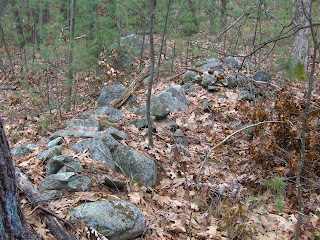 I walked into the woods on a trail starting from Teney Rd in northeastern Westford and was thinking about several different things when I topped a ridge and found some nice rock piles. I had anticipated finding something nice and was thinking: "If I find some rock piles, I should look carefully in the neighborhood for a, perhaps less conspicuous, rectangular mound...". Here is what I saw coming over the ridge:
I walked into the woods on a trail starting from Teney Rd in northeastern Westford and was thinking about several different things when I topped a ridge and found some nice rock piles. I had anticipated finding something nice and was thinking: "If I find some rock piles, I should look carefully in the neighborhood for a, perhaps less conspicuous, rectangular mound...". Here is what I saw coming over the ridge: From another angle:
From another angle: Following my own advice, I looked around when I got to these piles and spotted something like a house foundation across the road and downhill. Later, I decided this was the mound I was looking for.
Following my own advice, I looked around when I got to these piles and spotted something like a house foundation across the road and downhill. Later, I decided this was the mound I was looking for. So I want to recommend to other people hunting for rock pile sites: If you find some of those vertical sided piles, or piles evenly spaced and in lines, or piles along an outcrop and ridge where they form the horizon for a place slightly downhill; then you should check carefully to see if there is not some larger mound in the vicinity, perhaps slightly downhill. [Of course there are plenty of places without such a mound.]
So I want to recommend to other people hunting for rock pile sites: If you find some of those vertical sided piles, or piles evenly spaced and in lines, or piles along an outcrop and ridge where they form the horizon for a place slightly downhill; then you should check carefully to see if there is not some larger mound in the vicinity, perhaps slightly downhill. [Of course there are plenty of places without such a mound.] Still further downhill were a couple of smaller ridge/outcrop bumps that also were good candidates for marking the horizon, as viewed from the "house foundation". One turned out to be an outcrop while the other turned out to be an elongated rock pile (that reminded me of Pratt Hill):
 Another view:
Another view: These pictures do not show a detail which is that: there is a dip in the middle of the structure, breaking it into two pieces. Fifteen feet uphill and in line with the dip there was a smaller conical pile, Here is the view of that smaller pile, facing back uphill towards the "foundation" and the outcrop beyond that:
These pictures do not show a detail which is that: there is a dip in the middle of the structure, breaking it into two pieces. Fifteen feet uphill and in line with the dip there was a smaller conical pile, Here is the view of that smaller pile, facing back uphill towards the "foundation" and the outcrop beyond that: Off in another direction, forty yards across the slope and perhaps marking the horizon in that direction, was another outlier:
Off in another direction, forty yards across the slope and perhaps marking the horizon in that direction, was another outlier: This one had a little quartz:
This one had a little quartz: Let's take a closer look at the "house foundation".
Let's take a closer look at the "house foundation".
 I see smaller rocks used than I would expect in a house foundation and what is up with that wall dividing the space in half?
I see smaller rocks used than I would expect in a house foundation and what is up with that wall dividing the space in half? Do you see how similar this is to the sites along Falulah Brook in Fitchburg? I wonder if we'll eventually discover this type of site is pretty widespread. I especially offer the advice above with the hope of hearing from you, my colleagues, who are out exploring in other places.
********************
There is a different story here which I should not forget to tell: the story of confusing a large rectangular "burial" mound for a colonial house foundation.The characteristics of the one are not that far off from the other. The main mound here at Tenney Rd lacked structured walling, included smaller rocks but it was not that different from the poorhouse foundation(s) on Nagog Hill Rd.
1 comment :
It's in point of fact a nice and helpful piece of information. I'm happy that you simply shared this helpful information with us. Please stay us up to date like this. Thank you for sharing.
GameOn Video Gaming Console Storage - Green
Post a Comment